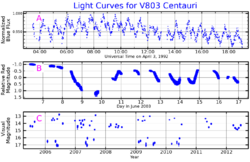Astronomy:V803 Centauri
From HandWiki
Short description: Star in the constellation Centaurus
 Three light curves for V803 Centauri, on three timescales, hours (plot A), days (plot B) and years (plot C). Adapted from Patterson et al. (2000),[1] Kato et al. (2004)[2] and Levitan et al. (2015)[3] | |
| Observation data Equinox J2000.0]] (ICRS) | |
|---|---|
| Constellation | Centaurus |
| Right ascension | 13h 23m 44.54s[4] |
| Declination | −41° 44′ 29.54″[4] |
| Apparent magnitude (V) | 13.2[5] (var) |
| Characteristics | |
| Spectral type | pec |
| U−B color index | -0.9 - -1.0[6] |
| B−V color index | 0.0.1[6] |
| Variable type | AM CVn[7] |
| Astrometry | |
| Proper motion (μ) | RA: -3.907[4] mas/yr Dec.: +11.978[4] mas/yr |
| Parallax (π) | 3.4885 ± 0.0599[4] mas |
| Distance | 930 ± 20 ly (287 ± 5 pc) |
| Absolute magnitude (MV) | 5.93[7] |
| Details | |
| White dwarf | |
| Mass | 0.9-1.2[7] M☉ |
| Donor star | |
| Mass | 0.06-0.11[7] M☉ |
| Other designations | |
| Database references | |
| SIMBAD | data |
V803 Centauri (V803 Cen) is a cataclysmic binary consisting of a dwarf helium star losing mass to a white dwarf. It is an example of the AM Canum Venaticorum (AM CVn) type of cataclysmic variable stars.[1]
References
- ↑ 1.0 1.1 Patterson, Joseph; Walker, Stan; Kemp, Jonathan; O'Donoghue, Darragh; Bos, Marc; Stubbings, Rod (2000). "V803 Centauri: A Helium‐rich Dwarf Nova". Publications of the Astronomical Society of the Pacific (The University of Chicago Press on behalf of the Astronomical Society of the Pacific) 112 (771): 625–631. doi:10.1086/316561. Bibcode: 2000PASP..112..625P.
- ↑ Kato, Taichi; Stubbings, Rod; Monard, Berto; Butterworth, Neil D.; Bolt, Greg; Richards, Tom (March 25, 2004). "V803 Centauri: Helium Dwarf Nova Mimicking a WZ Sge-Type Superoutburst". Publications of the Astronomical Society of Japan 56: S89–S98. doi:10.1093/pasj/56.sp1.S89. Bibcode: 2004PASJ...56S..89K.
- ↑ Levitan, David; Groot, Paul J.; Prince, Thomas A.; Kulkarni, Shrinivas R.; Laher, Russ; Ofek, Eran O.; Sesar, Branimir; Surace, Jason (January 2015). "Long-term photometric behaviour of outbursting AM CVn systems". Monthly Notices of the Royal Astronomical Society 446 (1): 391–410. doi:10.1093/mnras/stu2105. Bibcode: 2015MNRAS.446..391L.
- ↑ 4.0 4.1 4.2 4.3 4.4 Vallenari, A. et al. (2022). "Gaia Data Release 3. Summary of the content and survey properties". Astronomy & Astrophysics. doi:10.1051/0004-6361/202243940 Gaia DR3 record for this source at VizieR.
- ↑ Samus', N. N.; Goranskii, V. P.; Durlevich, O. V.; Zharova, A. V.; Kazarovets, E. V.; Kireeva, N. N.; Pastukhova, E. N.; Williams, D. B. et al. (2003). "An Electronic Version of the Second Volume of the General Catalogue of Variable Stars with Improved Coordinates". Astronomy Letters 29 (7): 468. doi:10.1134/1.1589864. Bibcode: 2003AstL...29..468S.
- ↑ 6.0 6.1 Elvius, A. (1975). "Variable blue object with a peculiar spectrum". Astronomy and Astrophysics 44: 117. Bibcode: 1975A&A....44..117E.
- ↑ 7.0 7.1 7.2 7.3 Solheim, J.-E. (2010). "AM CVn Stars: Status and Challenges". Publications of the Astronomical Society of the Pacific 122 (896): 1133–1163. doi:10.1086/656680. Bibcode: 2010PASP..122.1133S.
 |

